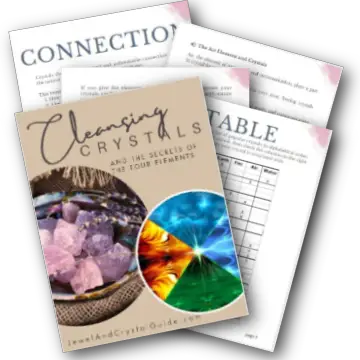Some rose quartz is a soft pink – almost with a fairy wing-like translucency to it – other rose quartz is vibrant, with a richer, cloudy pink blush. So what makes quartz pink and why do these variations in color occur?
The elements titanium, manganese, and iron give rose quartz its pink color, and the amount of and spread of these impurities determine the shades and depth of the coloring. But other things affect the shade of pink too, such as where the crystal is mined, who works on it, and what they do to it.
Below, I’ll go into detail about all the things that combine to give a rose quartz its pink color, so you understand why your crystal is the color it is and if the crystal will keep its pinkness over time.
In this blog post, you’ll:
- Find out how rose quartz forms
- Understand what 6 things give quartz a pink color and why
Impurities in rose quartz determine the crystal’s color
Rose quartz is made up of several elements, such as silicon, oxygen, and sodium. But it is the elements titanium, iron, and manganese that give rose quartz its pink color.
These three elements are called “impurities” because they aren’t in pure quartz (which is clear or translucent). And even though there is very little of these impurities in rose quartz, there’s enough to change the quartz’s color from clear to pink.
The more titanium, iron, and manganese there is in quartz, the deeper pink it appears. But rose quartz always ranges from light to medium pink, and even quartz with the highest levels of impurities is never dark pink.
Dark pink rose quartz is often fake and made from glass. Click here to find out how to tell if your rose quartz is real or not.

If you want to know how crystals get their colors, read this article next.
The spread of impurities determines the pink shades in rose quartz
The impurities titanium, iron, and manganese give rose quartz its pink color but they also create shades of pink within the quartz.
As the crystal is created in layers underground over millions of years, impurities get added to the layers. Sometimes more impurities are in one layer and sometimes less impurities find their way into the next layer.
Variations in the level of impurities create variations in how dark or light the pink is in the final crystal. More impurities create darker shades and less impurities form a lighter area in the quartz.
Smaller crystals are usually darker due to pressure and heat
Quartz is mainly made up of silica, which is a combination of silicon and oxygen. There’s a lot of silica in the Earth’s crust, and it’s carried around by very hot liquids, such as magma or water.
Quartz forms when a silica-rich liquid seeps through rocks and is deposited in empty pockets inside these rocks. The liquid cools down and the silica crystallizes, turning from a liquid into a solid. This can happen slowly and in layers over millions of years.
But how a pink quartz forms has a big influence on its final color and the shades within it…
Sometimes the liquid drips into small pockets inside rocks, where there isn’t much space. As the liquid fills the space and hardens, pressure is put on the forming crystal by the surrounding rock, and there’s usually a lot of heat there too.
This process creates a crystal as big as the original pocket in the rock. Because of the limited space there can’t be many layers in the crystal, so its overall coloring tends to be more consistent. And the heat inside often makes the crystal a darker pink naturally.
Sometimes silica-rich liquid drips into a hole that’s much bigger than a vein in a rock, so a large crystal or clusters of crystals form. Here there’s less pressure, more space, and more time for the crystal to form, so there’s more chance that the crystal will have different shades of pink in it.
But because there’s less heat here, these large rose quartz clusters are often lighter in color.
Some countries have dark pink quartz, others haven’t found it – yet
The country of origin of rose quartz can determine whether rose quartz is a darker shade of pink or not. All rose quartz mining countries around the world produce light pink rose quartz, but only a few countries have discovered pockets of darker pink quartz.
Light pink is the most common rose quartz color and the easiest to find in large clusters underground, no matter where it is mined. But even though only a handful of countries know where to find darker rose quartz, this number may increase as our technology and mining techniques improve with time.
So darker rose quartz might become more freely available in future.
Below is a list of countries where rose quartz is commonly mined, and where light pink and dark pink quartz is found:
| Countries That Mine Rose Quartz | Mines Pale Pink Rose Quartz | Mines Dark Pink Rose Quartz |
| Argentina | X | |
| Brazil | X | X |
| China | X | |
| India | X | X |
| Madagascar | X | X |
| Russia | X | |
| South Africa | X | X |
| United States | X |
Table showing a list of countries where rose quartz is commonly mined, along with the shade (light or dark) of the rose quartz.
As you can see from the table above, pale pink quartz is found in Argentina, Brazil, China, India, Madagascar, Russia, South Africa, and the United States. Of these countries, darker pink quartz is mined in Brazil, India, Madagascar, and South Africa.
Cutting, tumbling and polishing changes the color of rose quartz
Rose quartz that’s pulled from the ground is rough and uneven, and is called “raw rose quartz”. Raw rose quartz remains popular in crystal collections and you can buy raw rose crystal to use in meditations or sleep with it in your bedroom.
Smooth rose quartz is raw rose quartz that’s been cut into a shape by someone or tumbled in a machine with rocks to make it rounder and smoother. The final crystal can be polished after, to make it shine.
Cutting or tumbling quartz removes sections or layers from the crystal, to reveal the layers beneath. So rose quartz changes color according to the layer it shows. Remember that a layer with a lot of impurities is darker than a layer with very few impurities.
If cutting, tumbling, or polishing is done right, rose quartz reveals its beautiful colors within. But remove the wrong section or too much of the crystal, and you could end up with a dull stone that has almost no color at all.
Heat and radiation make rose quartz darker – for a while
The impurities titanium, manganese, and iron give rose quartz its color. But high heat and radiation damage these impurities and change their structure, which changes the color in rose quartz.
Rose quartz that’s exposed to temperatures above 930 °F (500 °C) or radiation turns darker pink, whether this treatment is done on purpose by people or the exposure happens in nature.
But these treatments can also structurally damage the crystal, causing cracks or fractures and changing the color of the inclusions (the white clouds that naturally occur in rose quartz).
The new darker pink color is not permanent – it fades over time, and when exposed to heat, sunlight, and/or chemicals.
Many gemological organizations and countries don’t recognize heat-treated or irradiated rose quartz as true rose quartz.











